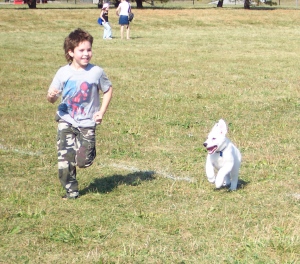We have shared our lives with man’s best friend for as long as 100,000 years now and quite naturally have developed a sense of familiarity, of closeness and understanding of one another. Many have speculated that because our social lifestyles are so similar, it was easy for wolves to slowly become part of our lives. Whether the gray wolves chose to hang around the humans of the time or the other way around is still in controversy, but one thing is sure, somewhere along the line, man and dog have found it mutually beneficial to stick together!
One would expect that, with such a long term relationship, humans and dogs would have acquired over the years a fairly accurate and efficient way to relate and communicate. It seems however, judging by the staggering number of impounded dogs every year, that we still have a long way to go in this area.
Many of us either consider our dogs as little humans in furry coats, and will project all sorts of human qualities (and shortcomings such as being ‘stubborn’ or ‘spiteful), while others, in an attempt to respect their differences in values, take some of the early models of hierarchy too far, generating stress and resistances in the relationship.
 We live in very exciting times, where the scientific world has opened its eyes to the richness of the dog’s world, long considered an artificial, man made creation, neglected by science. Today we’re finding out that what happens between our dogs’ ears lies somewhere in between those two perspectives. Certainly our dogs cannot understand when we try to explain in words why peeing on the new carpet is not an acceptable thing to do, but they are capable of anticipating our actions, reading our body language or identifying our emotions like no other animal. Through studies on dog cognition and the use of new technology like brain scans, after close to 100.000 years, we are on the road to finally find out what and how man’s best friend is thinking.
We live in very exciting times, where the scientific world has opened its eyes to the richness of the dog’s world, long considered an artificial, man made creation, neglected by science. Today we’re finding out that what happens between our dogs’ ears lies somewhere in between those two perspectives. Certainly our dogs cannot understand when we try to explain in words why peeing on the new carpet is not an acceptable thing to do, but they are capable of anticipating our actions, reading our body language or identifying our emotions like no other animal. Through studies on dog cognition and the use of new technology like brain scans, after close to 100.000 years, we are on the road to finally find out what and how man’s best friend is thinking.
Jennifer Cattet, Ph.D.
[youtube=http://www.youtube.com/watch?feature=player_embedded&v=UsJf9NwTFhw]
Related articles
- Why dogs are nice but wolves are mean (patheos.com)
- We Didn’t Domesticate Dogs. They Domesticated Us. (richarddawkins.net)
- VIDEO: When did dogs stop being wolves? (bbc.co.uk)
- Genetic analysis reveals how wolves evolved into dogs (rawstory.com)
- How Did Wolves Evolve into Man’s Best Friend? (mentalfloss.com)



The ability to have dogs unrestrained in the fMRI is a real breakthrough and a tribute to positive training. Here is one scientific paper on that approach. http://www.plosone.org/article/info%3Adoi%2F10.1371%2Fjournal.pone.0038027
from the previous study..”.. Historically, the usual approach has been to either anesthetize the animal……Based on the vast reinforcement learning literature, the observation of caudate activation to a hand signal associated with reward is not surprising. In fact, had this not been observed, one could rightfully question the feasibility of canine fMRI. The reward prediction error hypothesis of dopamine function suggests that dopamine is released in response to unexpected events that signal future reward…”
“…Third, positive reinforcement should be used whenever possible. Although we can imagine experiments in which one would like to know the differential effects of positive reinforcement versus punishment, we favor positive reinforcement for ethical reasons….”